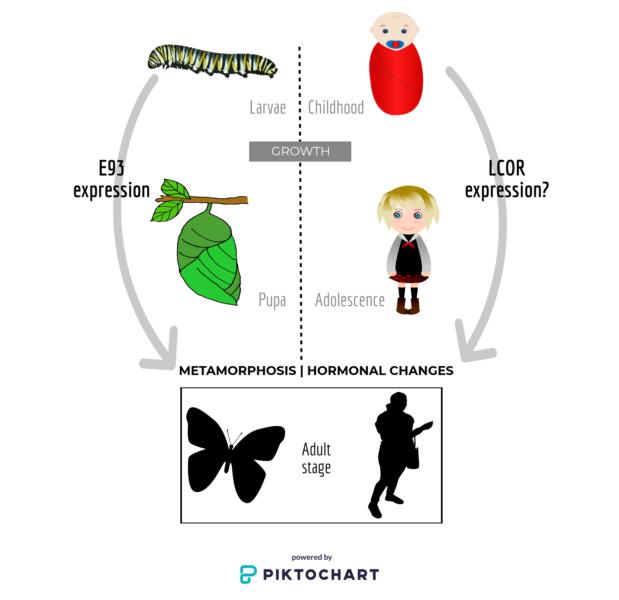David Martín and Xavier Franch lead the Evolution and Developmental Biology group of the Evolutionary Biology Institute (IBE: CSIC-UPF). In their study of metamorphosis they have identified the gene responsible for initiating this process. This discovery represents a paradigm shift in the vision that had so far existed of this process.
What was the classical paradigm of metamorphosis?
David: For a long time it has been thought that the control of metamorphosis was very simple, based on the repressive effect of a hormone, the juvenile hormone. When the juvenile hormone was present, the insect was immature and when the hormone disappeared the insect initiated the metamorphosis. It was thought that the juvenile hormone was continually preventing the onset of metamorphosis, since the insect came out of the egg until the metamorphosis was done. Our study redefines this process.
In what sense?
David: We have discovered a key piece, which is the gene called E93. We have seen that what is really important is the expression of E93, and not as much as it was thought the presence or absence of the juvenile hormone. This allows addressing issues of regulation and evolution of the metamorphosis that previously could not be addressed.
Does the juvenile hormone play no role in the metamorphosis?
David: Yes, in fact the juvenile hormone regulates the expression of E93. It keeps the insect as a larva or nymph because it doesn’t allow the expression of E93 until it reaches a certain point. What we have seen is that the juvenile hormone prevents metamorphosis from starting too soon, but it is the E93 gene that actually induces it. In addition E93 is necessary to promote the beginning of metamorphosis in all insects, including those that have complete metamorphosis, which is much more complex than the one that cockroaches have.
“ The juvenile hormone regulates the expression of E93 gene, which induces the metamorphosis”
David Martin
So, independently of the metamorphosis complexity, E93 is always present in this process?
Xavier: Yes, all insects have the gene E93, at least all those about which we have information. What we have also seen in this study is how the expression of E93 is regulated, in other words, how the animal knows that the moment of generating the pupa has arrived. At least partially, we have learnt that the weight or size of the animal determines this moment. What we still don’t know is the molecular mechanism by which this is done.
“The animal’s weight or size determines the activation moment of the gene E93”
Xavier Franch
David: It is completely unknown why an insect in a certain moment is capable of activating E93 and not before. We don’t know what happens, we don’t know the mechanism, and it is nothing related to the juvenile hormone. What we do know is that it is associated with size, as Xavi was saying, and this is one of the issues we are working on now.
And your future research focuses on the determination of this mechanism?
Xavier: Yes, we still have to know what is the relation between the size of the animal and the genes that it has to express in a certain moment. This is a paradigm in biology that is still not understood. What determines the size of animals? Insects are a good model to study it because there are a lot of different species with a lot of different sizes, too.
What about humans? Do we also have this gene?
Xavier: Yes, the gene does exist in humans! The gene in vertebrates that has the same features as E93 is called LCOR and it is related to the hormonal response, that is exactly the same role E93 has in insects. This response in humans consists in a rise of sexual hormones which produces most of the changes of adolescence. All of these hormonal changes would be the equivalent to the metamorphosis in insects. The larvae would be the equivalent to our childhood and the pupa would be to our adolescence; the animal gets out of the pupa in an adult stage as we do from adolescence. It would be interesting to see if LCOR has also an important role in this process from childhood to adult stage.
“Hormonal changes in adolescence would be the equivalent to insects’ metamorphosis”

David: It has not yet been studied in humans how long would immature development take, and which would be the moment when LCOR would determine the entrance to an adult stage. Maybe it is the moment to open the focus and start studying if LCOR in vertebrates has the same role that E93 has in insects.
And the reverse step? Would the inhibition of this gene allow the return to youth?
David: This is more complicated because one of the things that happen when the adult stage is formed is that cells are differentiated. In the laboratory, we have not been able to make an already differentiated adult return to the juvenile stage. Once a cell gets differentiated, there is no way back, at least not by inhibiting the expression of E93.
So eternal youth is still far…
Xavier: Well, what we have been able to do in the laboratory is to switch the E93 gene off during the development. What happens in cockroaches is that they remain in a juvenile stage until they die. They don’t have sexual maturation so they cannot reproduce. In the case of mealworm, with which we also experiment, the individual remains in larvae stages its whole life. It could stay long periods of time shedding from larvae to larvae. The equivalent for us would be to stay in adolescence during the rest of our lives – I don’t know if an eternal adolescence is what we want!
“When switching off the E93 gene, the individual remains in a juvenile stage until it dies. The equivalent for us would be to stay in the adolescence for the rest of our lives”
Check out the full interview (in Catalan) below.







